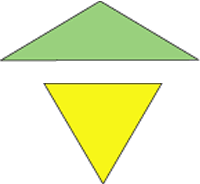Copyright © University of Cambridge. All rights reserved.
'Triangle Relations' printed from https://nrich.maths.org/
Show menu
Why do this problem?
The beauty of this problem is that it is completely open and therefore gives children the opportunity to approach it however they like. It is a great chance for you to observe and assess what they do, having conversations as you walk around the class.Possible approach
It might be appropriate for children to work in pairs or small groups and they will almost certainly need a cut-out copy of each triangle. (Here is a sheet of triangles which you could use.) It would be great to have other resources available for them to use should they want - for example rulers, pencils, squared paper, triangular dotty paper etc.Pupils will come up with a variety of different findings which might relate to side lengths, area, symmetry ... For example, some children might notice that you can halve each triangle to make two smaller triangles. The resulting four smaller triangles are in fact identical. Other children might notice that the area of each triangle is the same. You might want to bring out the fact that some of the things the triangles have in common could be exemplified in different ways.
